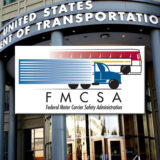Pay-by-the-mile system a ‘killer,’ driver compensation committee told
A pay-by-the-mile system costs drivers money and is a detriment to safety.
That was the message from Tom Weakley of the OOIDA Foundation to a committee tasked with determining how driver pay affects retention and overall safety performance.
“Compensation that pays by the mile is a killer,” Weakley said. “Compensation that pays by the mile will get you violations. Compensation that pays you by the mile is a problem that needs to be adjusted and worked with.”

The National Academies of Sciences’ Transportation Research Board driver compensation committee conducted an open meeting on Wednesday, Jan. 18. The morning included remarks and presentations from representatives of the Federal Motor Carrier Safety Administration and the Department of Labor. Industry stakeholders, such as the OOIDA Foundation, took the lead in the afternoon with a general message that the current pay structure combined with strict hours-of-service regulations creates an unenviable situation for truckers.
Rock and a hard place
“Truck drivers want to know if they have enough money to make their house payment,” Weakley said. “And if I don’t, what’s stopping me from doing that? Most of the rules and regulations aimed at improving safety for drivers are to cut back on the miles or the amount of time they have to run those miles. You expect them to abide by that when they have a house payment, a car payment, kids who need dental work and who want to participate in sports.”
Most truck drivers are paid by the mile instead of by the hour. In addition, the Fair Labor Standards Act exempts motor carriers from having to pay their drivers overtime. So there’s often no pay for when drivers are getting fuel, inspecting the load or waiting hours to be loaded or unloaded.
Weakley informed the committee that the standard in trucking is for shippers and receivers to have two hours to load or unload a truck. Meanwhile, a truck driver is likely donating that time.
“How many of you go to work for two hours before they start paying you?” Weakley asked the committee.
He also provided an example of a Louisiana carrier who was running legal but was having a lot of crashes. Weakley said the company decided to change its pay structure and began paying by the hour instead of by the mile.
“He wanted to create a job that was sustainable and that allowed a driver to have a family life,” Weakley said.
The company’s turnover rate dropped from 75% to 17%, and safety improved.
The driver compensation study was mandated by Congress as part of the 2021 infrastructure law. FMCSA was directed to task the Transportation Research Board with conducting a study on the effects of various methods of driver compensation on safety and driver retention, including hourly pay, payment for detention time and other pay methods used in the industry.
“This is a critical study to determine the kind of work environment that will help drivers stay in the industry … This is about driver retention. This is about safety,” FMCSA Administrator Robin Hutcheson said.
The committee conducted a closed session on Thursday, Jan. 19. LL









